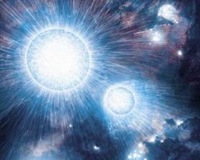
|
Cococubed.com
|
| Colliding White Dwarfs |
Home
Astronomy research
Software Infrastructure:
MESA
FLASH-X
STARLIB
MESA-Web
starkiller-astro
My instruments
Neutrino Emission:
Neutrinos from de-excitation
Neutrino emission from stars
Identifying the Pre-SN
Neutrino HR diagram
Pre-SN Beta Processes
Pre-SN neutrinos
White dwarf pulsations:
12C(α,γ) & overshooting
Probe of 12C(α,γ)16O
Impact of 22Ne
Impact of ν cooling
Variable white dwarfs
MC reaction rates
Micronovae
Novae
White dwarf supernova:
Stable nickel production
Remnant metallicities
Colliding white dwarfs
Merging white dwarfs
Ignition conditions
Metallicity effects
Central density effects
Detonation density
Tracer particle burning
Subsonic burning fronts
Supersonic fronts
W7 profiles
Massive stars:
Pop III with HST/JWST
Rotating progenitors
3D evolution to collapse
MC reaction rates
Pre-SN variations
Massive star supernova:
Yields of radionuclides
26Al & 60Fe
44Ti, 60Co & 56Ni
SN 1987A light curve
Constraints on Ni/Fe
An r-process
Effects of 12C +12C
Neutron Stars and Black Holes:
Black Hole spectrum
Mass Gap with LVK
Compact object IMF
He burn neutron stars
Stars:
Hypatia catalog
SAGB stars
Nugrid Yields I
He shell convection
BBFH at 40 years
γ-rays within 100 Mpc
Iron Pseudocarbynes
Pre-Solar Grains:
C-rich presolar grains
SiC Type U/C grains
Grains from massive stars
Placing the Sun
SiC Presolar grains
Chemical Evolution:
Radionuclides in 2020s
Zone models H to Zn
Mixing ejecta
Thermodynamics, Opacities & Networks
Radiative Opacity
Skye EOS
Helm EOS
Five EOSs
Equations of State
12C(α,γ)16O Rate
Proton-rich NSE
Reaction networks
Bayesian reaction rates
Verification Problems:
Validating an astro code
Su-Olson
Cog8
Mader
RMTV
Sedov
Noh
Software Instruments
2026 AAS Journals
AAS YouTube
Listing of 500+ Author Videos
AAS Peer Review Workshops
Outreach Material
Education Material
Other Stuff:
Bicycle Adventures
Illustrations
Presentations
Contact: F.X.Timmes
my one page vitae,
full vitae,
research statement, and
teaching statement.
In this article We systematically explore zero impact parameter collisions of white dwarfs (WDs) with the Eulerian adaptive grid code FLASH for 0.64 + 0.64 M$_{\odot}$ and 0.81 + 0.81 MM$_{\odot}$ mass pairings. Our models span a range of effective linear spatial resolutions from 5.2 $\times$ 10$^7$ to 1.2 $\times$ 10$^7$ cm. However, even the highest resolution models do not quite achieve strict numerical convergence, due to the challenge of properly resolving small-scale burning and energy transport. The lack of strict numerical convergence from these idealized configurations suggests that quantitative predictions of the ejected elemental abundances that are generated by binary WD collision and merger simulations should be viewed with caution.
Nevertheless, the convergence trends do allow some patterns to be discerned. We find that the 0.64 + 0.64 M$_{\odot}$ head-on collision model produces 0.32 M$_{\odot}$ of $^{56}$Ni and 0.38 M$_{\odot}$ of $^{28}$Si, while the 0.81 + 0.81 M$_{\odot}$ head-on collision model produces 0.39 M$_{\odot}$ of $^{56}$Ni and 0.55 M$_{\odot}$ of $^{28}$Si at the highest spatial resolutions. Both mass pairings produce $\simeq$ 0.2 M$_{\odot}$ of unburned $^{12}$C+$^{16}$O. We also find the 0.64 + 0.64 M$_{\odot}$ head-on collision begins carbon burning in the central region of the stalled shock between the two WDs, while the more energetic 0.81 + 0.81 M$_{\odot}$ head-on collision raises the initial post-shock temperature enough to burn the entire stalled shock region to nuclear statistical equilibrium.
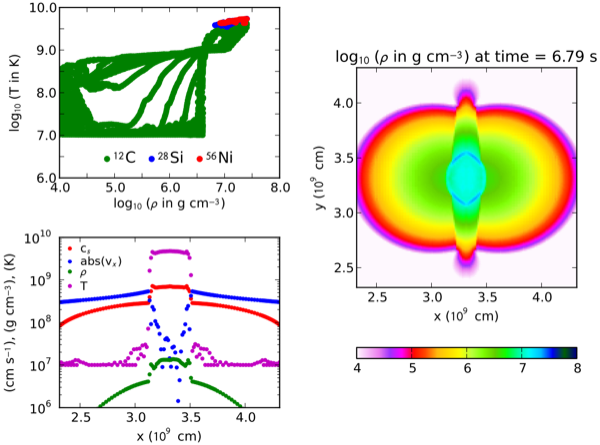
|

|

|
|
56Ni Production in Double-degenerate White Dwarf Collisions (collisions II, 2010)
In this article we present a comprehensive study of white dwarf collisions as an avenue for creating type Ia supernovae. Using a smooth particle hydrodynamics code with a 13-isotope, $\alpha$-chain nuclear network, we examine the resulting $^{56}$Ni yield as a function of total mass, mass ratio, and impact parameter. We show that several combinations of white dwarf masses and impact parameters are able to produce sufficient quantities of $^{56}$Ni to be observable at cosmological distances.
We find that the $^{56}$Ni production in double-degenerate white dwarf collisions ranges from sub-luminous to the super-luminous, depending on the parameters of the collision. For all mass pairs, collisions with small impact parameters have the highest likelihood of detonating, but $^{56}$Ni production is insensitive to this parameter in high-mass combinations, which significantly increases their likelihood of detection. We also find that the $^{56}$Ni dependence on total mass and mass ratio is not linear, with larger-mass primaries producing disproportionately more $^{56}$Ni than their lower-mass secondary counterparts, and symmetric pairs of masses producing more $^{56}$Ni than asymmetric pairs.
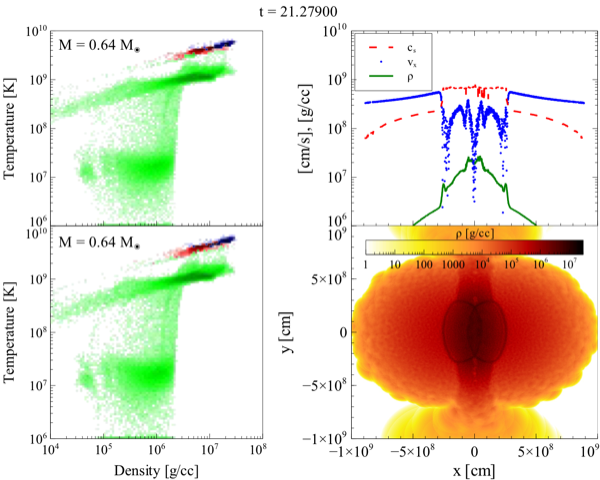
|
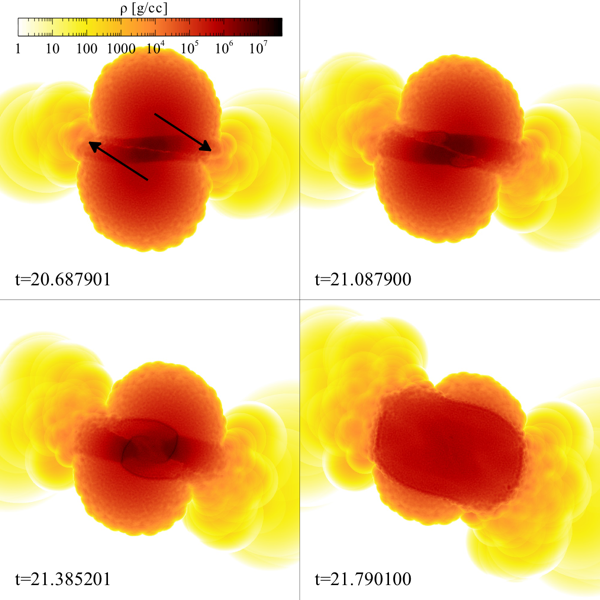
|
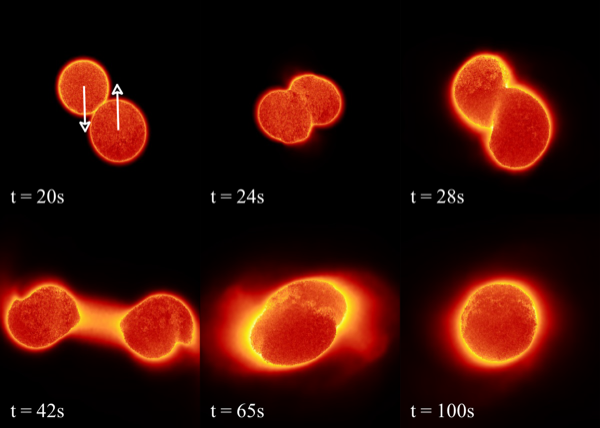
|
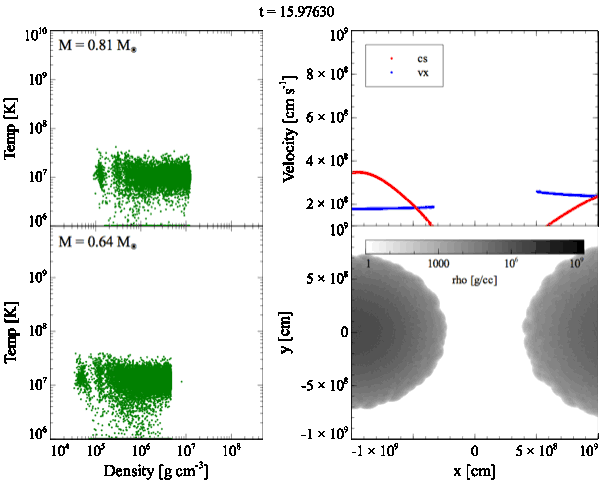
0.6x2comb.mp4, 0.6_0.8comb.mp4, 0.6_1.0comb.mp4 |

|
|
On Type Ia supernovae from the collisions of two white dwarfs (collisions I, 2009)
In this letter we explore collisions between two white dwarfs as a pathway for making Type Ia supernovae (SNIa). White dwarf number densities in globular clusters allow 10-100, redshift z $\lesssim$ 1 collisions per year, and observations by Chomiuk et al. of globular clusters in the nearby S0 galaxy NGC 7457 have detected what is likely to be a SNIa remnant. We carry out simulations of the collision between two 0.6 M$_{\odot}$ white dwarfs at various impact parameters and mass resolutions. For impact parameters less than half the radius of the white dwarf, we find such collisions produce $\simeq$ 0.4 M$_{\odot}$ of $^{56}$Ni, making such events potential candidates for underluminous SNIa or a new class of transients between Novae and SNIa.
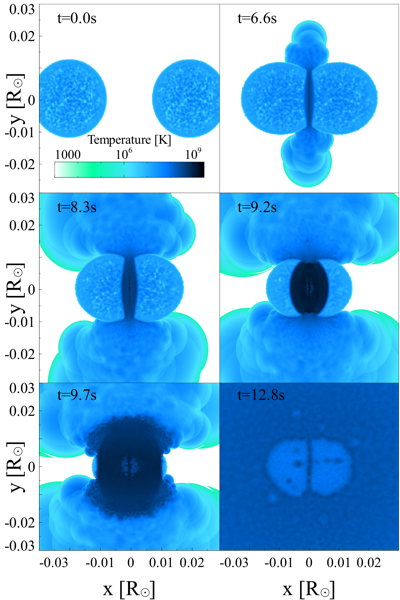
|

|
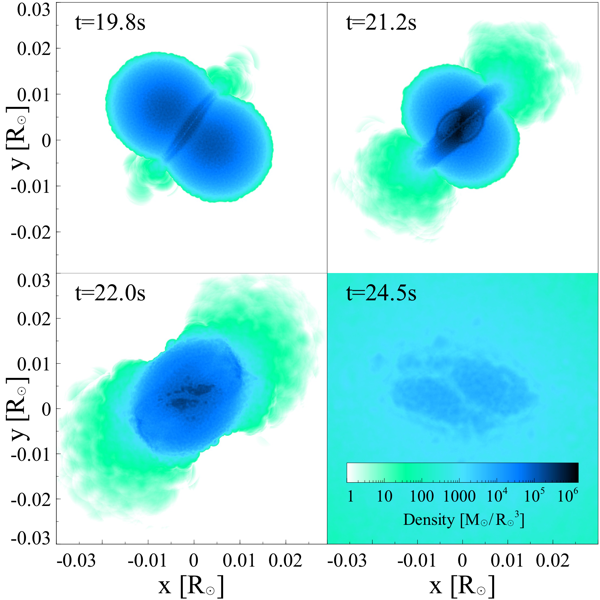
|

|